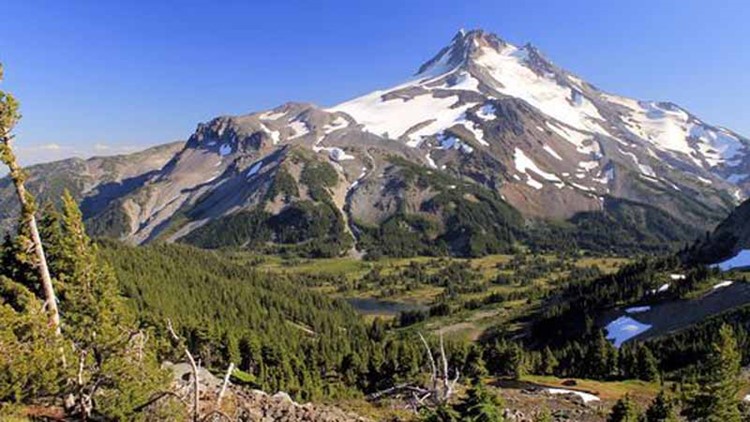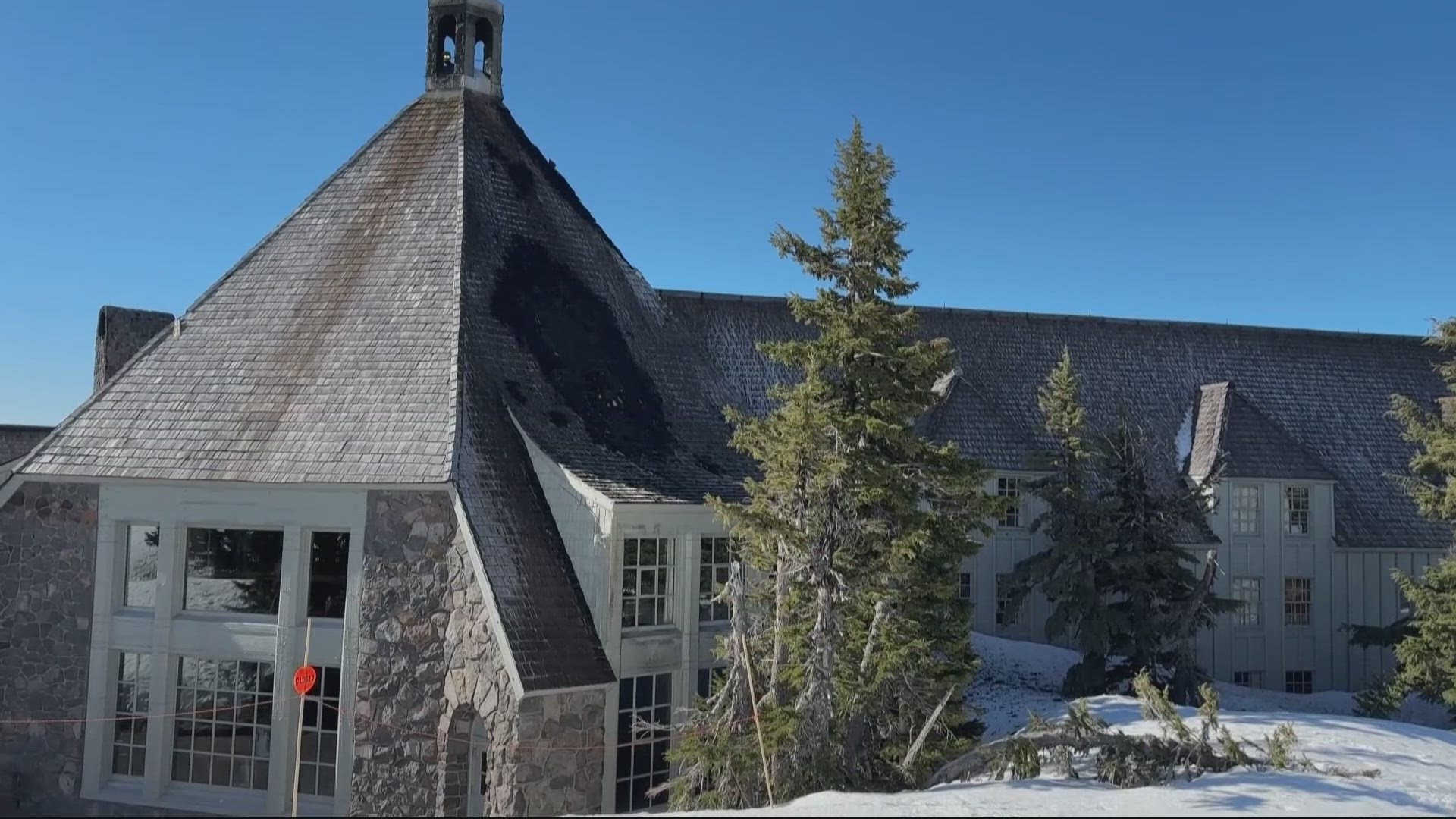A plan that could fundamentally change the way people visit five Oregon wilderness areas is moving into the final stages.
The U.S. Forest Service has proposed a system that would require hikers and backpackers to purchase a permit before traveling into half a million acres of backcountry between Mount Jefferson and Diamond Peak.
The plan seeks to address crowding and damage to sensitive alpine areas, and would apply to Mount Jefferson, Mount Washington, Three Sisters, Waldo Lake and Diamond Peak wilderness areas.
The federal agency announced the plan last year, and used public comments to develop five possible scenarios. A final decision is expected this summer, and the new system would begin summer 2019.
Now, the Forest Service wants to hear from the public again.
Four presentations are scheduled in Bend, Eugene and Salem in coming weeks (see full details below). The public has 30 days to comment on the plan, and can submit via email to: comments-pacificnorthwest-deschutes@fs.fed.us. The comment period closes May 21.
“Now is the time for people to comment and get their opinions on the record,” said Matt Peterson, co-leader of the project. “This could mean a big change, and we really want to hear people’s specific concerns so we can use it in our analysis.”
The permit system was proposed because of explosive growth in the number of people hiking and backpacking in Central Cascade areas around the Three Sisters and Mount Jefferson.
Unlike state or national parks, wilderness areas are often ill-equipped to handle masses of people, leading to damage in alpine environments.
In response, Deschutes and Willamette national forests proposed a permit system that would only allow a certain number of people to enter from trailheads into the five wilderness areas. The permits would cost $6 to $12 and be available to reserve at Recreation.Gov.
Limited entry permits are a fairly common tool across the West, but in Oregon, only a handful of places require them.
The Forest Service studied five scenarios in a report that was released last Friday, and will use them to guide a final decision expected sometime this summer.
The different scenarios are known as “alternatives” and range from least to most restrictive.
“The biggest thing we’re trying to do is find a balance between protecting these very special places — these places Congress set aside for the highest level of protection — while also doing it in a way that people can still enjoy them,” Peterson said.
Here’s a look at the alternatives and how they’d work, with details on why this is happening and the schedule of meetings and locations.
Alternative 1: No change
In this scenario, there would be no change in the status quo. The only places where a permit would be required are Pamelia Lake and Obsidian Trail. Both places have had a permit requirement since 1995.
Alternative 2: Permits required for most situations
This scenario would require hikers and backpackers to get a permit in many circumstances.
To start, any person backpacking and spending the night in the five wilderness areas would need a permit. There would be a limited number of permits available at each trailhead.
For example, there would be nine overnight permits available each day at popular Whitewater Trailhead east of Detroit.
In addition, any person day-hiking into Mount Jefferson, Three Sisters and Mount Washington would need a permit at a total of 48 trailheads.
At popular Marion Lake Trailhead, also into Mount Jefferson, there would be 40 day-use permits available each day.
A person wouldn’t need a permit if they were day-hiking into areas that are less popular, such as Waldo Lake or Diamond Peak wilderness areas, and other less visited trailheads.
“This proposal looks at limiting use in areas that are currently experiencing a lot of impact, and that have a lot of potential for growth and impact in the future,” Deschutes National Forest spokeswoman Jean Nelson-Dean said.
“It also adds a level of consistency, by requiring permits at all the trailheads along Cascade Lakes Scenic Byway and Highway 242.”
All of the following alternatives would have similar quotas. The only difference is where permits are required.
Alternative 3: Permits required at high-use trailheads
This scenario would establish a permit system at high-use trailheads in three of the wilderness areas: Mount Jefferson, Three Sisters and Mount Washington.
It’s meant to ease crowds at the busiest areas, while also allowing free access into places that currently don’t see as many visitors.
A permit would be required to camp overnight in the three wilderness areas. An additional reservation would be required to camp in the most popular zones.
That means a person who wanted to camp in Green Lakes Basin, in the Three Sisters, would need both a permit and a reservation in advance.
For day-hiking, a permit would be required at 19 trailheads.
“The focus here is looking at limits where there’s already significant impacts, and that have seen major growth,” Nelson-Dean said.
More: Spend the summer working in Oregon’s wilderness at one of these 13 jobs
Alternative 4: Permits required at high-use trailheads, plus a few more
This scenario also targets high use areas, but it folds in the permit requirement at “places that are gaining popularity and would be likely to get new visitors,” Nelson-Dean said.
A permit would be required to camp in all five wilderness areas — including Waldo and Diamond Peak. This scenario also includes the “additional reservation” requirement in the most popular zones.
For day-hiking, a permit would be required at 29 trailheads.
Alternative 5: permits for everything, everywhere
This scenario is simple: you’ll need a permit for overnight and day-use for all 101 trailheads in the five wilderness areas.
Why is this happening now?
The 1964 Wilderness Act called wilderness “an area where the earth and its community of life are untrammeled by man.”
But on the Cascade Crest — between Mount Jefferson and Diamond Peak — finding solitude in wilderness areas has been increasingly difficult.
The population boom in Bend and growth in the Willamette Valley have brought more people to the mountains each year, stressing the wilderness areas to the breaking point, officials said.
Visitors to the Three Sisters Wilderness jumped to 132,118 last year, up from just 46,999 in 2011, according to data collected by the Forest Service.
"I don't even consider it a wilderness experience," said Chris Sabo, trail crew supervisor for Deschutes National Forest in a 2013 interview. "It's almost more of an urban park. The use is very high, really beyond what this area can accommodate."
Closest to Salem, visitors to the Mount Jefferson Wilderness increased to 28,987 in 2016, up from 22,600 five years ago. Mount Washington was up 119 percent and Diamond Peak up 97 percent.
“The basic idea is that if use is too high, a limited entry system is a pretty simple way to get those numbers down,” said Beth Peer, who is leading the process for Deschutes National Forest.
Environmental damage
All those extra people have had a profound impact on areas that are supposed to have little evidence of human influence.
In addition to simple issues such as crowded trailheads and limited campsites, wilderness rangers have found increased amounts of poop, garbage and resource damage.
Wilderness rangers reported coming across unburied human feces more than 1,000 times. They reported hauling out more than 1,200 pounds of trash, according to documents.
"It's disheartening to go up there and see some of the behavior," said Jon Erickson, former wilderness ranger in the Three Sisters. "Every week we'd find people with illegal campfires, garbage left behind and unburied waste sitting right inside a camping spot.
"Yes, people are actually pooping at their own campsite and leaving it there."
Obsidian and Pamelia
One of the reasons officials cited for using a limited entry system is the success at Obsidian Trail and Pamelia Lake.
Both places were becoming crowded and struggling with overuse in the early 1990s, according to officials. In response, a limited entry system was installed that allows 20 groups into Pamelia per day, and 30 day hikers and 40 overnight visitors to Obsidian each day.
The results have been positive, said Troy Hall, an Oregon State University professor who has tracked environmental conditions at Obsidian.
“I’ve actually been surprised,” Hall said. “It’s pretty similar now to what it was 20 years ago, and it’s even improved a little. Other places, like Green Lakes in the Three Sisters that don’t have limited entry, have just gotten hammered.”
Hall said limited entry hasn’t always been an easy sell to the public. In the late 1990s, Mount Hood National Forest tried implementing a limited entry system, she said.
“It was pretty soundly rejected,” Hall said. “The public just wasn’t interested in taking that extra step.”
Public meetings on plan
The Forest Service is holding a series of open houses in Central Oregon and the Willamette Valley.
"The advantage of public meeting is the chance to have some back-and-forth, open things up for discussion and engage directly with people," Peterson said. "We're planning to share some of the details and our thinking on this project."
April 24: 5:30 -7 p.m. at the Sisters High School, 1700 McKinney Butte Road, Sisters, OR 97759.
April 26: 6 – 7:30 p.m. at the Deschutes National Forest Service Supervisor’s Office, 63095 Deschutes Market Road, Bend, OR 97701.
May 7: 6:30 – 8 p.m. at the Salem Convention Center, 200 Commercial St SE, Salem, OR 97301.
May 10: 6:30 – 8 p.m. at the Campbell Community Center, 155 High St, Eugene, OR 97401.
Visitors to Cascade Crest wilderness areas
Data collected by voluntary wilderness permits filled out at trailheads
Three Sisters
2016: 132,118
2011: 46,999
Mount Jefferson
2016: 28,987
2011: 22,600
Mount Washington
2016: 8,315
2011: 3,793
Diamond Peak (eastside access only)
2016: 2,716
2011: 1,378
Zach Urness has been an outdoors writer, photographer and videographer in Oregon for 10 years. He is the author of the book “Hiking Southern Oregon” and can be reached at zurness@StatesmanJournal.com or (503) 399-6801. Find him on Twitter at @ZachsORoutdoors.



